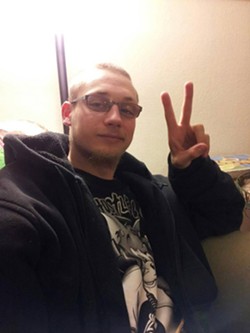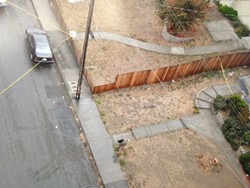Thursday, November 17, 2016
Expert Opinions Collide in EPD Shooting Trial
Posted By Kimberly Wear @kimberly_wear on Thu, Nov 17, 2016 at 10:17 PM
Attorneys rested their cases today in a federal wrongful death trial after presenting testimony from law enforcement experts who gave conflicting views on whether a Eureka police officer’s fatal shooting of Thomas “Tommy” McClain was justified.
A trio of police officers had McClain at gunpoint outside of his Allard Avenue home in the early morning hours of Sept. 17, 2014, when one of them — Officer Steven Linfoot — opened fire. McClain died later at the hospital.
Police say McClain was shot while defying a series of commands to keep his hands up by reaching for what looked to be a handgun tucked in his waistband but turned to be an unloaded BB gun. McClain’s family and one witness contend he had his arms raised and was trying to comply with conflicting commands when he was hit by three of Linfoot’s seven rounds.
Called to the stand by McClain’s parents’ attorney Dale Galipo was Roger Clark, a former lieutenant with the Los Angeles Sheriff’s Department whose last assignment was overseeing a multi-agency surveillance unit that targeted the “worst of the worst” didn't fire a shot over a five-year span. He said Eureka officers made several tactical errors.
“None of the shots were justified, in my opinion,” Clark said.
Defense expert Don Cameron, who currently trains police officers in the Bay Area, disagreed. He testified that the officers had “no alternative” to shooting once McClain made a movement to his waistband.
“That would be a shoot situation,” Cameron said.
McClain came onto police radar by chance. Two officers, Stanley Harkness and Ryan McElroy, testified earlier this week that while conducting a surveillance operation targeting one of McClain’s neighbors, they saw McClain confront a man and fiddle with what appeared to be a gun.
Police decided to send Linfoot to drive past the house to scare McClain inside but it didn’t work. After the squad car passed, Harkness and McElroy said they saw McClain take out the replica gun, rack it and then return it to his waistband, piquing the officers’ concerns about the safety of their sergeant who was arriving on scene.
McClain was shot after a brief interaction with the officers. Linfoot, who has attended each day of the trial, was the only one to open fire.
The two experts offered dueling opinions on just about every aspect of EPD’s handling of the situation — from officers' initial contact with McClain to the appropriateness of more than one officer giving commands to whether they should have taken cover.
Clark said McClain “can’t be held responsible” for not doing precisely what officers expected and they should have taken some of his actions as “confusion generated by the commands” because he had been showing signs of compliance.
On a dash cam video from Linfoot’s car, officers can be heard yelling at McClain to keep his hands up before a shout of “get down” just before shots ring out. Linfoot has testified that the voice on the tape sounds like his, but he believed it was an interrupted command to come forward.
Clark also noted that McClain came on to the officers’ radar by happenstance and a sudden interaction with officers can led to confusion and anxiety that hampers compliance. Officers should have tried to stabilize the situation before directing him to come forward, Clark said.
“In my view, it was a continuous escalation until the shots were fired,” he said.
Cameron described the officers’ actions as appropriate and said they didn’t have time to wait and see if McClain had his hands on the replica gun, saying a suspect can draw a pistol from a waistband in seconds and get a shot off.
“If I wait until the threat … represents itself and I haven’t reacted at that point, then I’m trying to catch up,” Cameron said.
He also said it’s not uncommon for a second officer to back up another’s commands if they are not met with compliance. He said he didn’t view a shout of “get down” just before that shooting as conflicting with commands for McClain to put his hands up because he had previously been told to come down to officers on the sidewalk.
Under questioning from Galipo, Cameron did say that might cause a person to lower their hands.
While Clark criticized the officers for not taking cover because it would have given them more time to clear up misunderstandings and determine if their commands were sinking in, Cameron said a direct approach can allow officers to downplay a situation to gain a suspect’s cooperation.
The city’s attorney Nancy Delaney also called to the stand Alexander Jason, a specialist in reconstructing the shooting scenes, who testified physical evidence from the incident was consistent with officers’ descriptions.
Video shows Linfoot taking a large step backward just before he first fires his gun and continuing to move backward as he fires off more rounds, Jason testified.
“This would be a response to a perceived sudden and immediate threat,” he said.
Saying Linfoot’s seven shots were fired in 2.3 seconds, Jason testified that he believes the first round missed McClain, causing him to twist into a protective stance with his right shoulder tucked down as he was hit by a bullet in the right bicep, which travel into his chest and fractured his spine.
The shape of the wound indicates McClain’s bicep was up against his chest when the bullet entered, Jason said, but “we don’t know what his hands were doing or his forearm.”
The wife of McClain’s cousin, who was out on the porch when the shooting occurred, testified Wednesday that she saw McClain walking toward police with his hands raised at chest level when he was shot.
Jason also testified that he believes the second bullet pierced McClain’s right temple causing “massive damage” and the third round hit him in the buttock, which would be consistent with the way his body was found lying on the ground with his back to the street.
Under questioning from Galipo, Jason said it’s possible that the first four shots missed McClain and that Linfoot’s backward motion could have been reacting to one of the other officers yelling out “gun.”
Capt. Brian Stephens, who at the time of the shooting was a patrol sergeant and oversaw the surveillance effort, briefly retook the stand, testifying his intention was to have as controlled a conversation as possible when he first contacted McClain.
“I didn’t want to escalate the situation in any way,” he said.
Closing arguments are scheduled to begin Friday morning before the case is handed off to the jury of five women and one man.
A trio of police officers had McClain at gunpoint outside of his Allard Avenue home in the early morning hours of Sept. 17, 2014, when one of them — Officer Steven Linfoot — opened fire. McClain died later at the hospital.
Police say McClain was shot while defying a series of commands to keep his hands up by reaching for what looked to be a handgun tucked in his waistband but turned to be an unloaded BB gun. McClain’s family and one witness contend he had his arms raised and was trying to comply with conflicting commands when he was hit by three of Linfoot’s seven rounds.
Called to the stand by McClain’s parents’ attorney Dale Galipo was Roger Clark, a former lieutenant with the Los Angeles Sheriff’s Department whose last assignment was overseeing a multi-agency surveillance unit that targeted the “worst of the worst” didn't fire a shot over a five-year span. He said Eureka officers made several tactical errors.
“None of the shots were justified, in my opinion,” Clark said.
Defense expert Don Cameron, who currently trains police officers in the Bay Area, disagreed. He testified that the officers had “no alternative” to shooting once McClain made a movement to his waistband.
“That would be a shoot situation,” Cameron said.
McClain came onto police radar by chance. Two officers, Stanley Harkness and Ryan McElroy, testified earlier this week that while conducting a surveillance operation targeting one of McClain’s neighbors, they saw McClain confront a man and fiddle with what appeared to be a gun.
Police decided to send Linfoot to drive past the house to scare McClain inside but it didn’t work. After the squad car passed, Harkness and McElroy said they saw McClain take out the replica gun, rack it and then return it to his waistband, piquing the officers’ concerns about the safety of their sergeant who was arriving on scene.
McClain was shot after a brief interaction with the officers. Linfoot, who has attended each day of the trial, was the only one to open fire.
The two experts offered dueling opinions on just about every aspect of EPD’s handling of the situation — from officers' initial contact with McClain to the appropriateness of more than one officer giving commands to whether they should have taken cover.
Clark said McClain “can’t be held responsible” for not doing precisely what officers expected and they should have taken some of his actions as “confusion generated by the commands” because he had been showing signs of compliance.
On a dash cam video from Linfoot’s car, officers can be heard yelling at McClain to keep his hands up before a shout of “get down” just before shots ring out. Linfoot has testified that the voice on the tape sounds like his, but he believed it was an interrupted command to come forward.
Clark also noted that McClain came on to the officers’ radar by happenstance and a sudden interaction with officers can led to confusion and anxiety that hampers compliance. Officers should have tried to stabilize the situation before directing him to come forward, Clark said.
“In my view, it was a continuous escalation until the shots were fired,” he said.
Cameron described the officers’ actions as appropriate and said they didn’t have time to wait and see if McClain had his hands on the replica gun, saying a suspect can draw a pistol from a waistband in seconds and get a shot off.
“If I wait until the threat … represents itself and I haven’t reacted at that point, then I’m trying to catch up,” Cameron said.
He also said it’s not uncommon for a second officer to back up another’s commands if they are not met with compliance. He said he didn’t view a shout of “get down” just before that shooting as conflicting with commands for McClain to put his hands up because he had previously been told to come down to officers on the sidewalk.
Under questioning from Galipo, Cameron did say that might cause a person to lower their hands.
While Clark criticized the officers for not taking cover because it would have given them more time to clear up misunderstandings and determine if their commands were sinking in, Cameron said a direct approach can allow officers to downplay a situation to gain a suspect’s cooperation.
The city’s attorney Nancy Delaney also called to the stand Alexander Jason, a specialist in reconstructing the shooting scenes, who testified physical evidence from the incident was consistent with officers’ descriptions.
Video shows Linfoot taking a large step backward just before he first fires his gun and continuing to move backward as he fires off more rounds, Jason testified.
“This would be a response to a perceived sudden and immediate threat,” he said.
Saying Linfoot’s seven shots were fired in 2.3 seconds, Jason testified that he believes the first round missed McClain, causing him to twist into a protective stance with his right shoulder tucked down as he was hit by a bullet in the right bicep, which travel into his chest and fractured his spine.
The shape of the wound indicates McClain’s bicep was up against his chest when the bullet entered, Jason said, but “we don’t know what his hands were doing or his forearm.”
The wife of McClain’s cousin, who was out on the porch when the shooting occurred, testified Wednesday that she saw McClain walking toward police with his hands raised at chest level when he was shot.
Jason also testified that he believes the second bullet pierced McClain’s right temple causing “massive damage” and the third round hit him in the buttock, which would be consistent with the way his body was found lying on the ground with his back to the street.
Under questioning from Galipo, Jason said it’s possible that the first four shots missed McClain and that Linfoot’s backward motion could have been reacting to one of the other officers yelling out “gun.”
Capt. Brian Stephens, who at the time of the shooting was a patrol sergeant and oversaw the surveillance effort, briefly retook the stand, testifying his intention was to have as controlled a conversation as possible when he first contacted McClain.
“I didn’t want to escalate the situation in any way,” he said.
Closing arguments are scheduled to begin Friday morning before the case is handed off to the jury of five women and one man.
Speaking of...
-
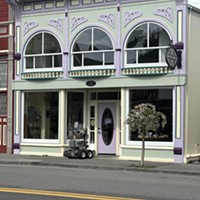
UPDATE: Artillery Shell Deemed Safe in Ferndale
Apr 12, 2024 -
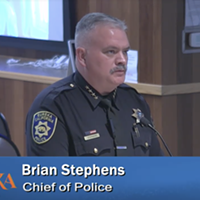
EPD Officer Found to Have Failed to Investigate Sexual Abuse Allegation
Jan 30, 2024 -
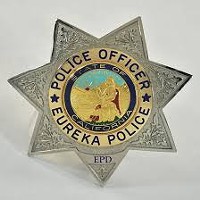
EPD Identifies Suspect Killed in Standoff
Jan 23, 2024 - More »
Comments (3)
Showing 1-3 of 3
Readers also liked…
more from the author
-
Dust to Dust
The green burial movement looks to set down roots in Humboldt County
- Apr 11, 2024
-
Our Last Best Chance
- Apr 11, 2024
-
Judge Rules Arcata Can't Put Earth Flag on Top
- Apr 5, 2024
- More »
